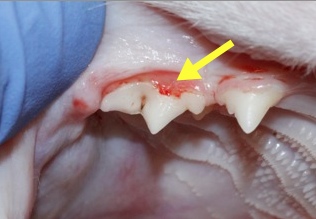News
Archive for the ‘Pet of the Month’ Category
Pet of the Month Dec 2013
by on November 29th, 2013
Category: Pet of the Month, Tags:
 Archie was diagnosed with an advanced type of blood cancer called lymphoma in September. He started a treatment called the Wisconsin protocol but did not respond so he was referred to a specialist oncology department, who put him on a ‘rescue’ protocol. Archie will be 6 on December 1st. Amazingly he doesn’t know he is sick and apart from one stay in hospital on intravenous fluids for sickness and diarrhoea he is currently enjoying a good quality of life. His favourite game is playing with his ball.
Archie was diagnosed with an advanced type of blood cancer called lymphoma in September. He started a treatment called the Wisconsin protocol but did not respond so he was referred to a specialist oncology department, who put him on a ‘rescue’ protocol. Archie will be 6 on December 1st. Amazingly he doesn’t know he is sick and apart from one stay in hospital on intravenous fluids for sickness and diarrhoea he is currently enjoying a good quality of life. His favourite game is playing with his ball.
Pet of the Month Nov 2013
by on November 5th, 2013
Category: Pet of the Month, Tags:
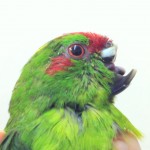 When Pudge, a parakeet, accidentally flew into a window two months ago it was with horror that his owner found he had broken off his upper beak. An avian specialist was contacted but it was decided that reattaching the beak would not be possible. His owners initially had to give Pudge lots of assistance to help him cope with his obvious difficulty eating but soon Pudge adapted and he has coped very well.
When Pudge, a parakeet, accidentally flew into a window two months ago it was with horror that his owner found he had broken off his upper beak. An avian specialist was contacted but it was decided that reattaching the beak would not be possible. His owners initially had to give Pudge lots of assistance to help him cope with his obvious difficulty eating but soon Pudge adapted and he has coped very well.
Almost ten weeks have passed and we are delighted to report that Pudge’s upper beak has started to regrow
Pet of the Month October 2013
by on September 30th, 2013
Category: Pet of the Month, Tags:
 The observant among you will remember Poppy as having appeared on this page last November.
The observant among you will remember Poppy as having appeared on this page last November.
A sweet and easy going Labrador Poppy has really been through the mill yet again. Some weeks ago she became depressed and reluctant to jump in the car although she continued to eat and drink and did not vomit as was the case last year.
Investigation showed free abdominal fluid which when analysed indicated septic peritonitis. Peritonitis is an inflammation of the membrane which lines the inside of the abdomen and all of the internal organs and is a serious and potentially life-threatening condition.
An exploratory operation showed Poppy had a kebab stick lodged in her liver! This was promptly removed and we are delighted to report that she is making an excellent recovery to date.
Pet of the Month – September 2013
by on September 2nd, 2013
Category: Pet of the Month, Tags:
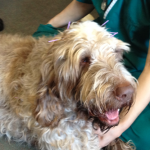 This month’s Pet of the Month is the delightful Italian Spinone Mungo who received acupuncture at the practice for some months as an ancillary aid to control his epilepsy.
This month’s Pet of the Month is the delightful Italian Spinone Mungo who received acupuncture at the practice for some months as an ancillary aid to control his epilepsy.
The use of acupuncture in China dates back at least 3000 years however it now seems clear that therapeutic techniques involving piercing the body developed independently in many communities around the world up to 7000 years ago. The mammalian system incorporates a complex system of sensory modulation. In childhood, we all learn to take advantage of this when our parents teach us to ‘rub it better’.
This soon becomes conditioned behaviour and in adult life as we suffer more chronic muscular pains and aches we often massage deep into our aching muscles in an attempt to relieve pain. It does not take a great leap of the imagination to see how such behaviours may have progressed in certain communities until the skin was pierced at sites of tender muscle. This was observed to be a very efficient therapy and before long maps of the body describing the common sites of tenderness would have been produced.
At Fitzalan House we use Western Medical Acupuncture as a therapy following orthodox clinical diagnosis predominantly, although not exclusively, in the treatment of musculoskeletal disorders and chronic pain states in animals. Points are chosen based on the principles of nervous system function and the identification of trigger points – tender points in a taut band of muscle which can cause referred pain. Science and acupuncture no longer represent opposing poles of medical opinion as more and more evidence is found to support and explain the mechanisms by which acupuncture achieves its results.
The specific effects of acupuncture needling are achieved through stimulation of the peripheral nervous system (the part of the nervous system that excludes the brain and spinal cord) and neuromodulation (the process in the nervous system in which several classes of chemicals called neurotransmitters regulate diverse populations of nerve cells) of the central nervous system, which occurs as a consequence. Acupuncture also stimulates the release of pain-relieving chemicals in the brain and spinal cord such as endorphins, which produce more generalised analgesia. These effects, combined with local needling of painful trigger points, result in exceptional pain relief.
Although primarily used for analgesic purposes acupuncture is used for many varied reasons including epilepsy, enhanced wound healing, control of vomiting, stroke rehabilitation and influence on the immune system, to mention just a few.
Pet of the Month – July 2013
by on August 14th, 2013
Category: Pet of the Month, Tags:
A concerned member of the public had pushed a note through our practice door in Arundel informing us that a cat had apparently fallen into the River Arun and had managed to scramble out but the note said it didn’t look good. The RSPCA had been contacted but said they would not be able to attend for some time. The note showed where the cat could be found and had the phone number of the person who had spotted her. After speaking to the lady, who didn’t think the cat would last much longer, our vet Ellie went to investigate.
Peering over the wall where the cat had last been seen Ellie could see the little cat, huddled up and shivering. The lady was right, it didn’t look good. Ellie climbed over the wall and down onto the ledge where she was and lifted her out from the bushes. The poor cat was wet through and freezing cold and quite disorientated. She began crying so loudly that the nearby neighbours came out to see what the racket was. One local kindly fetched a towel and Ellie returned to the practice with a very cold and confused little cat. She didn’t have any injuries except for badly damaged nails from trying to scramble up the riverbank but was suffering from hypothermia. Her temperature was so low it wouldn’t even read on the thermometer. A nurse quickly collected the cat and took it back to Littlehampton for hospitalisation.
Once there she was put on warm intravenous fluids and placed in a warming oxygen tent. After a few hours her temperature returned to normal and she began to look much happier. Thankfully Emily was micro-chipped and so we were able to contact her owners who came straight down to see her. The following day she was able to go home. We hope she won’t go exploring too close to the river again.
Pet of the Month – July 2013
by on July 1st, 2013
Category: Pet of the Month, Tags:
 Lula has made a fantastic recovery from a broken hind leg she sustained in a road traffic accident. Lula loves spending her nights on the prowl looking for mice. Sadly her adventures proved costly when she was clipped by a car. Thankfully she was relatively unscathed apart from her leg, which after the insertion of a steel pin and six weeks cage rest has completely healed.
Lula has made a fantastic recovery from a broken hind leg she sustained in a road traffic accident. Lula loves spending her nights on the prowl looking for mice. Sadly her adventures proved costly when she was clipped by a car. Thankfully she was relatively unscathed apart from her leg, which after the insertion of a steel pin and six weeks cage rest has completely healed.
Pet of the Month – June 2013
by on May 31st, 2013
Category: Pet of the Month, Tags:
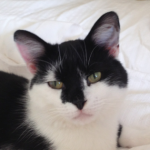 Dudley has been a real star. When he was first brought in to our clinic he was dribbling and having difficulty in eating. It soon became apparent that he was suffering from Feline Odontoplastic Resorptive Lesions often shortened to ‘Tooth Resorption’. He has made a swift recovery from the trauma of the multiple tooth extractions which were necessary to relieve his pain. This condition represents one of the most common diseases seen in domestic cats and occurs in 20-75% of cats depending on the population studied.
Dudley has been a real star. When he was first brought in to our clinic he was dribbling and having difficulty in eating. It soon became apparent that he was suffering from Feline Odontoplastic Resorptive Lesions often shortened to ‘Tooth Resorption’. He has made a swift recovery from the trauma of the multiple tooth extractions which were necessary to relieve his pain. This condition represents one of the most common diseases seen in domestic cats and occurs in 20-75% of cats depending on the population studied.
Older and purebred cats are more likely to be affected and the numbers of teeth that can be affected increases with age. This unusual condition was probably first identified properly in the 1920’s although the problem has now been demonstrated in the teeth of cats dating back to the 13th and 14th centuries!! Also the domestic cat’s larger relatives haven’t escaped this one as similar lesions have been identified in wild cats including Lions and Tigers.
Despite this being a common condition, the cause of tooth resorption is still not known. Recent studies have suggested that Vitamin D metabolism may be important but as yet there is no known way of preventing the condition from developing.
What Are The Signs of Tooth Resorption in Cats?
Initially cats with affected teeth may not show any symptoms at all. However once a significant amount of erosion of the tooth develops and is visible, the condition will usually then result in pain. As the disease progresses the symptoms your cat may show include difficulty in eating, dribbling saliva, face rubbing, jaw chattering and weight loss.
How is Tooth Resorption Diagnosed?
Tooth resorption is usually diagnosed by your vet during a dental check up often as part of the full clinical examination that will be carried out before a booster vaccination or if your cat is not well. They can also be detected if your vet has the opportunity to examine your cat’s teeth under a general anaesthetic. Not all cases of tooth resorption are obvious. Sometimes they can be hidden beneath the gum line and dental x-rays are required to detect them. See picture enclosed.
How is Tooth Resorption Treated?
The treatment for all teeth with tooth resorption is extraction as they are likely to cause pain as the disease progresses and there is no medical treatment to cure this problem. The extraction of teeth in cats is usually a surgical procedure. The teeth can be fragile and tricky to remove. Fortunately, most patients recover rapidly after tooth extraction and will often be much happier once these painful teeth have been extracted.
Pet of the Month May 2013
by on May 3rd, 2013
Category: Pet of the Month, Tags:
 Eddie a delightful Staffordshire Bull Terrier absolutely loves playing with his ball. He is athletically built, carries not an ounce of excess weight and exhibits not only the speed of a greyhound but also the agility of a working collie.
Eddie a delightful Staffordshire Bull Terrier absolutely loves playing with his ball. He is athletically built, carries not an ounce of excess weight and exhibits not only the speed of a greyhound but also the agility of a working collie.
Unfortunately Eddie’s feet tend to bear the brunt of his acute decelerations and changes of direction and he has suffered numerous cuts to his pads and broken nails. We have put Eddie on supplements to try and fortify his nails against the harsh treatment that he meters out on them and hope that this measure will keep his visits to the clinic to a minimum.
Pet of the Month April 2013
by on April 3rd, 2013
Category: Pet of the Month, Tags:
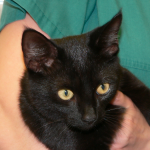 Jess is a beautiful 8-year-old black cat who came into the surgery because she had lost her appetite. Her teeth were in need of attention and she was also vomiting. Despite appropriate medication Jess continued to be sick so blood tests were carried out, and she was medicated by injection as well as receiving intravenous fluids.
Jess is a beautiful 8-year-old black cat who came into the surgery because she had lost her appetite. Her teeth were in need of attention and she was also vomiting. Despite appropriate medication Jess continued to be sick so blood tests were carried out, and she was medicated by injection as well as receiving intravenous fluids.
The blood tests suggested liver involvement but were not 100% conclusive. We therefore next carried out an ultrasound scan of Jess’ liver and placed an oesophagostomy feeding tube, as Jess was still not eating and would not tolerate syringe feeding. Her teeth were also cleaned and polished.
Oesophagostomy tubes are a type of feeding tube that passes through the side of the neck directly into the oesophagus (gullet). They are held in place with sutures and the area is bandaged for patient comfort. They are usually tolerated very well and can remain in place for months without any problems. The daily food requirement for the patient is worked out and fed in regular small amounts. The food we use is highly calorific and liquidised. If the tube gets blocked then we use coke to unblock it! The bandage is changed twice daily and the surgical wound site is cleaned at the same time.
Our scan showed Jess’ liver to be abnormal and mottled. An exploratory laporotomy was carried out and biopsies were taken to give us more information about her condition. As Jess recovered from her anaesthetic she developed a pneumothorax which is when air enters the chest cavity and deflates the lungs. She was placed in an oxygen tent and treated appropriately until it had resolved. This is a very rare and unusual occurrence that we felt related to an anatomical abnormality in her chest and not the surgery.
Jess recovered well from surgery and was sent home with her tube in place. She gradually started to eat more and more and brightened up. The biopsy results showed no sign of a tumour, and it was supposed that Jess had suffered inflammatory bowel disease or a localised peritonitis with some liver involvement.
Jess’ feeding tube was removed after being in place for just under four weeks. All medication was discontinued and she was put on a prescription diet.
Luckily Jess was insured so we were able to provide the very best possible care for her in what turned out to be a long and very complex case. We are thrilled that Jess is now a happy bright cat who is eating normally again.
Pet of the Month – March
by on March 5th, 2013
Category: Pet of the Month, Tags:
 Dottie, a delightful ‘Morky’ (Maltese Cross Yorkshire Terrier) puppy had to visit the surgery recently for fear she had eaten some rat bait. She was walking on farmland and was found nosing around in a box of blue granules. In case she had eaten some of the potentially fatal anticoagulant that is used in most rat baits, we injected her with a drug to make her vomit, which did indeed prove she has eaten some of the deadly poison. She was also given some Vitamin K1 to try and counteract the effect of any granules she might have already absorbed into her system, and follow up blood tests were carried over the following week to monitor her progress. A classic example of prevention better than cure!
Dottie, a delightful ‘Morky’ (Maltese Cross Yorkshire Terrier) puppy had to visit the surgery recently for fear she had eaten some rat bait. She was walking on farmland and was found nosing around in a box of blue granules. In case she had eaten some of the potentially fatal anticoagulant that is used in most rat baits, we injected her with a drug to make her vomit, which did indeed prove she has eaten some of the deadly poison. She was also given some Vitamin K1 to try and counteract the effect of any granules she might have already absorbed into her system, and follow up blood tests were carried over the following week to monitor her progress. A classic example of prevention better than cure!


